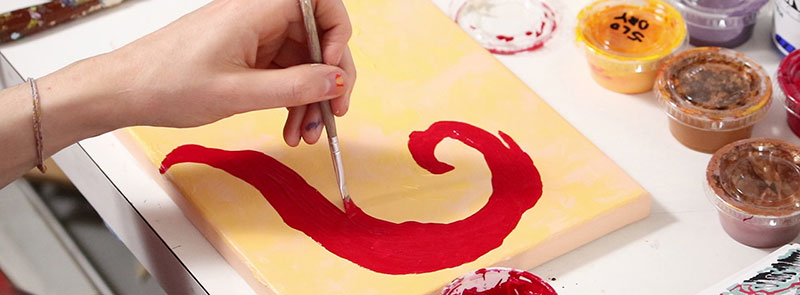Prompt
Create 3 color charts, for each complementary color pair:

This color chart is very effective in terms of training your eye to see subtle shifts of color, to develop a more sensitive color mixing technique, and mixing different levels of saturation with the opposite color instead of relying on straight white and black out of the tube.
Examples
@croooolik, Cynthia, Anna

Step 1
Draw 9 circles. Circle 5 is for your “perfect” grey. Circles 1 & 9 are the complementary color pairs, below you see purple and yellow.
Step 2
Start by painting the complementary color pairs into circles 1 & 9. Paint in the colors straight out of the tube, without adding any white. If you don’t have a tube of purple paint, mix a red and blue together to make the purple.

Step 3
To mix the swatch for 8, take 9 and mix a little touch of 1. Add enough white to 8 so that in terms of value, it’s about a mid grey.
Look at 8 and ask yourself if it looks like a less saturated yellow. If you mix 8 and it looks like a greenish yellow, you’ll want to push it to be more grey by adding a touch of red. (red is the complementary of green, therefore adding red will make the mixture more grey)
Step 4
When you adjust your mixtures, don’t paint over where the first mixture. For example, if you are mixing 8, but decide that you want to adjust it, after you adjust that mixture, paint it where 10 is. If you adjust 10, paint it where 11 is, and so forth.
Perhaps mixing 8 took 6 different mixtures: 10, 11, 12, 13, 14, 15. Look at what makes these 6 mixtures slightly different from each other, that’s what you want to train your eye to see with this exercise.

Step 5
Take 8 and add a little touch of purple to create 7. You can basically push 7 so that it is a step closer to 5, which is your “perfect gray.”
Repeat the prior step to mix 7 and 6, where you made adjustments and painted several swatches. Any time a mixture seems to start pushing too much towards another color, add the complementary color to push it more towards grey.
For example, if your mixture is starting to look really blue, add some orange to make it more grey.

Step 6
When you come to mix 5, you want to get it as close to a “perfect grey” as possible. Don’t stress out if it’s not “perfect” (it won’t be) as the purpose of this exercise is the experience of mixing, not getting the most accurate chart.
Step 7
Repeat the prior steps, but this time start with 1 and work towards 5.
Tips
- Add plenty of white to your paint mixtures! If you don’t, your mixtures will be too dark, and it will be difficult to see the subtle shifts in the grey tones. It’s better to err on having too much white, rather than not enough.
- Don’t add too much water to your paint, you want your color swatches to be opaque. If your paint is too thin and transparent, it will be tough to see the mixtures clearly.

- The aim is not to get the “right” mixture right away, no one does!
- You’ll make tons of adjustments to each swatch of color and that’s exactly the objective of the exercise.
- You should end up with many attempts of mixtures on your paper, and that’s good!
- Add paint to your mixtures in tiny increments, a little goes a long way. It’s a lot easier to add more of a color little by little, than to add too much at once and then to have practically start over from scratch
Art media
We recommend using gouache, but you can use any opaque paint media, (watercolor won’t work) this prompt won’t work with digital or drawing media.
You can use our supply lists as a guide: gouache, acryl gouache, acrylic, oils, water mixable oils

Red & Green
Complementary colors are a fundamental part of color theory that can vastly influence how you use color.
Explained in this vide is the way the complementary colors are laid out in the color wheel, as well as how complementary colors can be implemented into paintings.
Discussion led by Art Prof Clara Lieu and Teaching Artist Alex Rowe.
Blue & Orange
This video focuses on blue and orange as an example of complementary colors, discussing how complementary colors can be implemented into artworks of various media.
Discussion led by Art Prof Clara Lieu and Teaching Artists Alex Rowe and Lauryn Welch.
Yellow & Purple
This video explains the basics of how complementary colors work, focusing on purple & yellow. An explanation for how complementary colors are laid out in the color wheel is provided, as well as how complementary colors can be implemented into paintings.
Discussion led by Art Prof Clara Lieu and Teaching Artists Deepti Menon and Lauryn Welch.




